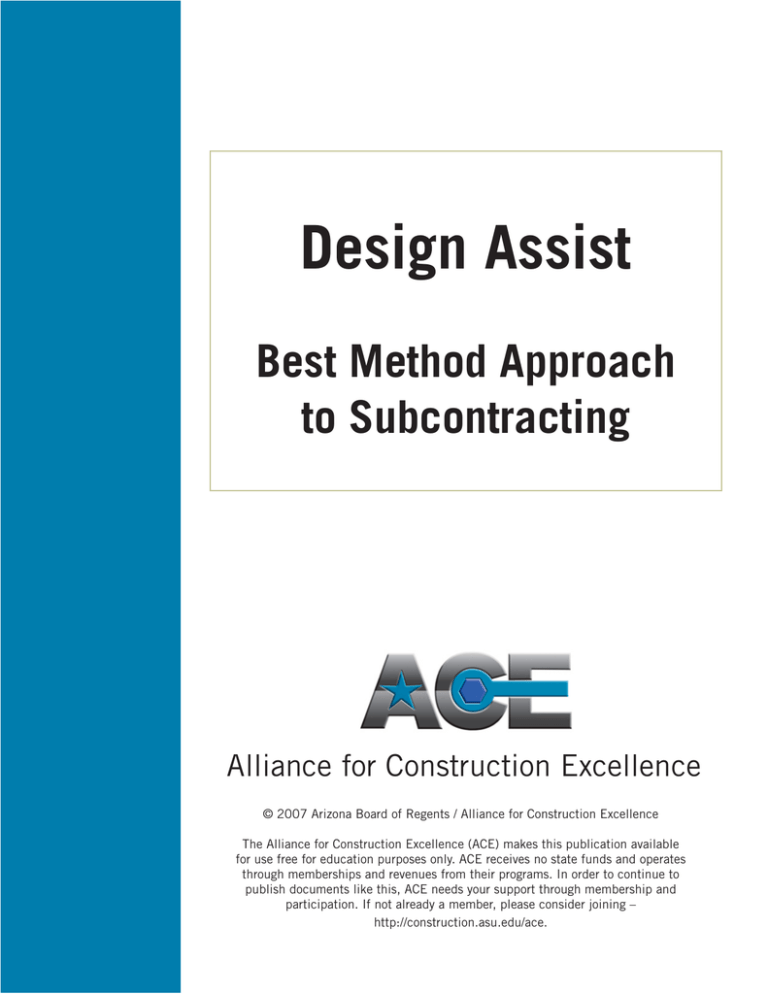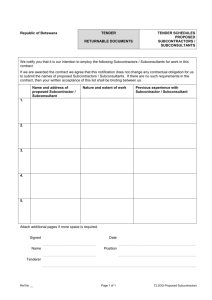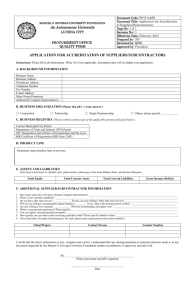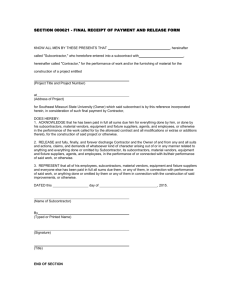Design Assist - Alliance for Construction Excellence
advertisement

Design Assist Best Method Approach to Subcontracting Alliance for Construction Excellence © 2007 Arizona Board of Regents / Alliance for Construction Excellence The Alliance for Construction Excellence (ACE) makes this publication available for use free for education purposes only. ACE receives no state funds and operates through memberships and revenues from their programs. In order to continue to publish documents like this, ACE needs your support through membership and participation. If not already a member, please consider joining – http://construction.asu.edu/ace. DESIGN ASSIST Best Method Approach to Subcontracting TABLE OF CONTENTS SECTION A Introduction 1. Preface 2. Introduction 3. Benefits SECTION B - Design Assist Subcontractor Selection Process 1. Project Delivery Method Needs Assessment 2. Project Delivery Method Needs Assessment Flow Chart 3. Design Assist Subcontractor Selection Process SECTION C Design Assist Services & Deliverables 1. Design Assist Best Methods Flow Chart 2. Design Assist Services & Deliverables Matrix 3. Glossary of Terms design assist - best method approach to subcontracting © 2007 Arizona Board of Regents / Alliance for Construction Excellence A. INTRODUCTION 1. PREFACE The intent of this publication is to offer a Best Method Approach to delivering projects using Design Assist. The guidelines offered are intended to educate Project Teams on the benefits of utilizing Design Assist Services. This publication will address the timing for the selection of the Design Team, CM@Risk, and the Design Assist Subcontractors, as well as offering a Design Assist Subcontractor Selection Process found in Section B. This publication will also describe the design assist process by use of the Design Assist Best Methods Flowchart, and the Design Assist Services & Deliverables Matrix found in Section C. 2. INTRODUCTION Design Assist is a collaborative team-oriented project delivery method Design Assist is a collaborative that capitalizes on the benefits of early engagement of Design Assist team-oriented project delivery Subcontractors. Using the Design Assist Process, the project team is able method that capitalizes on the to utilize the specialty expertise of the Design Assist Subcontractors in benefits of early engagement of both the design and construction phases to optimize project cost, value and design assist subcontractors. constructability efficiency. The objective of the Design Assist Process is to minimize design and constructability related issues prior to construction, thus maximizing the overall value, speed of construction, and quality of the final product. The Design Assist process is not intended to transfer any design liability to Design Assist Subcontractors. 3. BENEFITS The major benefits of the Design Assist Delivery Method are faster project delivery, elimination of costs caused by inefficient and un-constructible designs, improved design document coordination, better control of the effects of design creep on the budget, and best value options and systems analysis. By selecting Design Assist Subcontractors early and allowing them to collaborate with the project team during the design, many activities related to construction pre-planning can be completed earlier than in a traditional design-bid-build delivery method. Many times this means that the combined design and construction schedule can be shortened allowing earlier project completion and owner occupancy. Faster delivery, or a higher level of certainty in delivery, can correlate to savings in project cost. The major benefits of the design assist delivery method are: • Faster project delivery • Reduction in design errors & omissions costs • Better control of design creep • Best value options and systems analysis Design Assist allows designers and contractors to work as a collaborative team in the design phase, enabling them to detect and resolve design problems and constructability issues prior to construction. The net result is a reduction in design errors and omissions costs through corrective changes incorporated during the design phase. This helps greatly reduce design related RFI’s during the construction phase when they are more costly and time delaying. The Design Assist process results in a well thought out and pre-coordinated design that will improve the efficiency and quality of the construction installation. design assist - best method approach to subcontracting © 2007 Arizona Board of Regents / Alliance for Construction Excellence PAGE A. INTRODUCTION By working directly with the design consultants to obtain a clear and complete understanding of the overall design, Design Assist Subcontractors are able to more accurately estimate the project early and manage or mitigate cost and escalation issues before they impact the project budget. They can also aid the project by tracking the costs and working with the design consultants to ensure that the developing design stays within the budget, while maintaining the intended functionality and level of quality. Value is added by ensuring that there are no budget overruns due to design creep, while still maintaining functionality and quality standards. Using a proactive team approach will yield a best value design. By providing design reviews, cost information and design alternatives early in the design phase, Design Assist Subcontractors can advise and guide the design to achieve a cost efficient, quality design that does not exceed the budget. To successfully execute Design Assist projects, and reap the potential benefits all active participants must have a clear understanding of the overall design assist process and must work as a team using a common method. They must understand their respective roles and responsibilities at each step. Use of the guidelines offered in this publication to achieve these ends will result in a Project Team with aligned goals, shared ownership, and a mutually successful project. design assist - best method approach to subcontracting © 2007 Arizona Board of Regents / Alliance for Construction Excellence PAGE B. DESIGN ASSIST SUBCONTRACTOR SELECTION PROCESS 1. PROJECT DELIVERY METHOD NEEDS ASSESSMENT In the early stages of a project, before any Team members are brought on board, an Owner should review his project’s goals and objectives in order to assess the Project Delivery Method best suited for his project. The benefits of utilizing Project Delivery Methods such as CM@Risk with Design Assist subcontractors, traditional Design-Bid-Build and Design-Build should be weighed against the project’s critical goals and objectives. Once the Owner has determined the Project Delivery Method, he can now select the best Project Team that can work within the parameters of the Project Delivery Method determined in the Needs Assessment. The Owner should select his team members in the following order: 1. Design Team (Architect and Consultant Team) and CM@Risk 2. Design Assist Subcontractors/Major Suppliers (through CM@R’s selection process) 3. Pre-qualified, Competitive Bid Subcontractors/Major Suppliers (through CM@R’s selection process) See the Project Delivery Methods Needs Assessment Flowchart attached on the following page. The Request for Proposal and subsequent contracts for all of the above Project Team services should include language that acknowledges active participation in the Design Assist Services and Deliverables Matrix outlined in Section C. This Design Assist Best Method Approach assumes a Needs Assessment that results in the selection of a CM@Risk Project Delivery Method. The CM@Risk Project Delivery Method is most conducive to qualificationsbased selection for Design Assist subcontractors/Major Suppliers and the collaborative team-oriented environment needed for Design Assist services to be successful. Critical Activities: 1. Fast-track schedule 2. Control design and budget creep . Coordination of complex scope during design . Best Value Systems Analysis . Sustainability Elements of Design Once the CM@Risk Project Delivery Method has been selected, the Owner must now review his/her project for the best approach to purchasing his CM@Risk’s subcontracted construction services. If the project goals and objectives require any critical activities listed below, an Owner may choose to utilize the Design Assist process for certain “Project Critical” Subcontractors/Major Suppliers in order to better ensure the success of the project. Critical Activities: 1. Fast-track schedule 2. Control design and budget creep 3. Coordination of complex scope during design 4. Best Value Systems Analysis 5. Sustainability Elements of Design Once the Owner has completed his Project Delivery Method Needs Assessment and has chosen the Design Assist Subcontractor Delivery Method, he is now ready to begin the selection process for building his Project Team. design assist - best method approach to subcontracting © 2007 Arizona Board of Regents / Alliance for Construction Excellence PAGE B. DESIGN ASSIST SUBCONTRACTOR SELECTION PROCESS 2. PROJECT DELIVERY METHOD NEEDS ASSESSMENT FLOWCHART Owner Assesses Critical Project Goals & Objectives to Determine Best Project Delivery Method Traditional DesignBid-Build Method CM@Risk Method Design-Build Method One Step Design-Build Projects May be Candidates for the Design Assist Process Assess Critical Project Goals and Objectives for Need to Use Design Assist Subcontractor Delivery Method: Fast Track Schedule Control Design and Budget Creep Coordination of Complex Scope During Design Best Value Systems Analysis Select Design Team Select CM@Risk Select Design-Assist Consultants & Subcontractors design assist - best method approach to subcontracting © 2007 Arizona Board of Regents / Alliance for Construction Excellence PAGE B. DESIGN ASSIST SUBCONTRACTOR SELECTION PROCESS 3. DESIGN ASSIST SUBCONTRACTOR SELECTION PROCESS At the appropriate time indicated on the Design Assist Best Methods Flowchart in Section C, the selection of Design Assist Subcontractors and Major Suppliers should be made in order to attain the full benefit of their services. The CM@Risk should develop a Design Assist Subcontractor/Supplier Selection Plan that meets the Owner’s and Designer’s approval and includes them in the process. This plan should include: A) A Design Assist Subcontractor Request For Proposal (RFP) that includes: 1. Program description of Construction Scope 2. A list of Design Assist services and deliverables required for the project along with a request for their experience in these deliverables 3. Responsibility Matrix 4. Overall Project Schedule 5. Request for Key Selection criteria: (personnel organizational chart and resumes, firms financial qualifications, relevant experience, and project specific criteria such as sustainability) 6. Description of the Design Assist contracting method to be used (Lump Sum, Cost plus fee) 7. A declaration of one of two ways to select Design Assist Subcontractors and Major Suppliers: Qualifications-based selection: Qualifications-based selection can be utilized when good program design direction is not available for the Design Assist Subcontractor. In this case the design assist subcontractors and suppliers expertise can be utilized in the development of program design criteria and subsequent cost models. Qualifications and Price Component-based Selection: Qualifications and price component-based selection can be utilized when well defined program criteria is available. The price component can be broken down into two parts: Part 1 – Design Assist Services: The Part 1 Price Component will consist of the Design Assist Subcontractor’s Design Phases Services fee and, if schedule requires, some early work costs. Part 2 – Construction Services Part 2 Price Component (lump sum method) will consist of the Design Assist Subcontractor’s Opinion of Construction Cost for the project. Or: The Part 2 price component (cost plus fee) will consist of Fees and General Conditions cost, with direct cost to be determined during the design assist phase. Note: Qualifications and Price Component-based selection can be accomplished in a 1 or 2 Step process. The Subcontractor’s ability to maintain his Price Components during Design Assist Services should be a requirement for award of Part 2, Construction Services. B) An interview process with short-listed Design Assist subcontractor finalists to review key selection criteria and/ or qualifications-based and/or price component elements of the RFP. C) Award of the Design Assist Subcontract should be a Two-Part Agreement with Design Services followed by Construction Services whenever possible. Successful completion of Design Services should be a requirement for the award of Part 2, Construction Services. design assist - best method approach to subcontracting © 2007 Arizona Board of Regents / Alliance for Construction Excellence PAGE C. DESIGN ASSIST SERVICES & DELIVERABLES 1. DESIGN ASSIST BEST METHODS FLOWCHART design assist - best method approach to subcontracting © 2007 Arizona Board of Regents / Alliance for Construction Excellence PAGE C. DESIGN ASSIST SERVICES & DELIVERABLES 2. DESIGN ASSIST SERVICES & DELIVERABLES MATRIX Roles and Responsibilities Activity Owner Architect/Engineer Design Assist Subs / Manufacturer’s Reps CM@R Contract Award Ensure that CM@R and Designer Contracts require compliance with the Design Assist Delivery Method. Identify, qualify, and select Design Assist Subcontractors and Manufacturer’s Reps Present qualifications for selection Design Assist Agreements Review and approve CM@R recommendations for Design Assist Review and comment on CM@R recommendations Award to most qualified proposer with two part award; Design Phase Agreement and Construction Contract. Team Meetings / Design Workshops / GMP Workshops / Progress Meetings Communicate project requirements to Design Phase Team. Communicate design updates including anticipated changes. Provide analysis on design impacts to project schedule and budget. Provide analysis on design impacts to project schedule within area of expertise. Document Review and Comment Review documents at each stage of design and provide comments. Provide design documents for review and respond and/or incorporate accepted comments. Identify and manage all open document review comments thru resolution. Participate in review meetings and provide comments. Baseline Cost Model Hold a Budget review meeting. Gain mutual agreement that pricing adequately covers intended final scope. Review and approve cost model to establish project budget. Attend Budget review meeting. Gain mutual agreement that pricing adequately covers intended final scope. Review and approve design assumptions and qualifications detailed in cost model. Prepare a cost budget. Attend Budget review meeting. Gain mutual agreement that pricing adequately covers intended final scope. Provide Baseline cost model with assumptions and qualifications. Prepare a cost budget. Attend Schematic Budget review meeting. Gain mutual agreement that pricing adequately covers intended final scope. Provide anticipated scope of work and opinion of cost. Design Phase Schedule Review and approve the project preconstruction/construction schedule. Provide input to the project preconstruction/construction schedule. Develop an overall project schedule that is mutually agreeable to all parties including key milestone dates. Provide input to the project preconstruction /construction schedule. Milestone Estimates Review and approve estimates. Provide design documents at predetermined intervals for estimating purposes, typically provided at Schematic, Design Development and Construction Documents. Estimates provided at predetermined design intervals to validate current design against Baseline Cost Model. Estimates provided at predetermined design intervals to validate current design against opinion of cost. Dynamic Estimating / Trend Logs Review and approve major revisions to the basis of design Review Alternative strategies and interim cost updates to facilitate most effective design approach. Provide dynamic estimating updates for design evolution between milestone estimates. Provide dynamic estimating updates for scope evolution between milestone estimates. design assist - best method approach to subcontracting © 2007 Arizona Board of Regents / Alliance for Construction Excellence PAGE C. DESIGN ASSIST SERVICES & DELIVERABLES Roles and Responsibilities Architect/Engineer CM@R Design Assist Subs / Manufacturer’s Reps Activity Owner Alternative Strategy / Value Analysis Review VE options with users and make selections of approved options. Work with construction team to develop VE options. Incorporate approved options into design documents. Work with design team to develop VE options and submit cost savings for review and acceptance. Manage and update VA log for tracking. Work with design team to develop VE options and submit cost savings for review and acceptance. Permitting Strategy Identify requirements for any fees and permits under owner control and track progress thru issuance. Identify permit requirements, lead times, responsible team member, and generate permit strategy. Identify requirements for any permits under CM@R control and track progress thru issuance. Identify subcontractor responsibilities (i.e. Life Safety) Constructability / Bidability Review and Comment Review and comment on function of design, preference on equipment, finishes, etc. Respond, incorporate, and/or resolve comments from team members Review and comment on construction means and methods, alternative strategies, drawing conflicts, and generate mechanism to track incorporation to documents. Review and comment on construction means and methods, alternative strategies, and drawing conflicts. Construction Schedule Review and approve CM@R recommendations. Review and comment on CM@R recommendations. Generate a preliminary schedule during Design Development and enhance to a final construction schedule during the Preconstruction process. Provide input for preliminary construction schedule and updates thru the Preconstruction process. 3D CAD Coordination (BIM) Participate in identification of areas of project that would benefit from BIM Participate in identification of areas of project that would benefit from BIM and generate necessary drawings. Manage coordination meetings to identify potential space conflicts. Identify potential space conflicts and provide coordination models to minimize clashes. Identify long-lead items at potential cost escalation risk. Submit early release requests as required to meet schedule and budget. Procurement Strategy Review and approve CM@R recommendations. Review and comment on CM@R recommendations. Identify long-lead items at potential cost escalation risk. Submit early release requests to meet schedule and budget. Site Logistics Plan Review and approve CM@R recommendations. Review and comment on CM@R recommendations. Identify construction requirements and present a plan for approval Provide critical space requirements for proper performance of the work. Prepare Bid Documents / Generate GMP / Approve GMP Review and approve GMP including pricing, clarifications and qualifications, General Conditions, etc. Review and comment to owner on price, clarifications and qualifications, General Conditions, etc. Generate a GMP document for review and approval. Identify any clarifications, qualifications, General Conditions, etc. Generate a subcontract bid for all work categories under scope of work and submit for approval. design assist - best method approach to subcontracting © 2007 Arizona Board of Regents / Alliance for Construction Excellence PAGE C. DESIGN ASSIST SERVICES & DELIVERABLES 3. GLOSSARY OF TERMS Team Meetings: Meetings between the Project Team members: Owner, Design Team, CM@Risk and Design/Assist Subcontractors to discuss design issues, design coordination, budget, construction issues and overall progress. Design Workshops: Design Workshops involve meetings between the Design team, A/E Consultants, CM@Risk and Design/Assist Subcontractors. Owner’s representatives are also encouraged to participate. Design Workshops will focus on A/E teams fully disclosing the intent of the design and project vision as well as coordinating the design between the various disciplines. Later Design Workshops entail “over the shoulder” design review and comment regarding constructability. Progress Meetings: Progress Meetings will be held with CM@Risk (Design Assist Subcontractors if necessary), Design Team, and Owners representatives to discuss progress of design documents, budget projections, and assumptions. Document Review and Comment: The process wherein the CM@Risk, Owner and Design Assist Subcontractor’s periodically review the design documents and provide feedback and comments with regard to constructability, completeness and budget conformance. These review comments should be a matter of record. Baseline Cost Model: The Baseline Cost Model is a preliminary cost model developed from the earliest available design documents, typically Program level documents. The Baseline Cost Model, once approved by the Owner becomes the Teams Project Budget. All Project team members should have buy-in to the Baseline Cost Model. Design Phase Schedule: The Design Phase Schedule represents the plan for completing the design effort in order to begin construction. This plan typically includes design time, estimating time, owner approval processes, long lead early equipment procurement, phased bid packages, GMP Approval process and other critical activities that must be accomplished to release the Project for construction. Milestone Estimates: Milestone Estimates are pre-planned times during design when the Design team agrees to issue documents so that the CM@Risk and design assist subcontractors can perform complete estimates and check the progress of the design against the Baseline Cost Model. Typical Milestone Estimates would be done at Schematic, Design Development and 50% Construction Documents. Dynamic Estimating/Trend Logs: Dynamic Estimating or Trending describes the process of tracking design issues and deviations from the Baseline Cost Model assumptions as design progress between Milestone Estimates. In this way the estimate is always current with the design. The CM@Risk and design assist subcontractors track issues and deviations as they learn them in Team Meetings, Design Workshops and Progress Meetings. Alternative Strategy/Value Analysis: Alternative Strategies/Value Analysis is a process wherein the CM@Risk and the design assist subcontractors review the design documents and Project Systems and offer alternatives for consideration by the Owner and Design team. These alternatives are intended to present opportunities for best value and/or cost savings. Permitting Strategy: Permitting Strategies ensure that the design is being developed in a manner that is most conducive to the start of construction. Often times on fast-track Projects the design must be packaged in a manner that facilitates phased permitting for release of construction work. design assist - best method approach to subcontracting © 2007 Arizona Board of Regents / Alliance for Construction Excellence PAGE C. DESIGN ASSIST SERVICES & DELIVERABLES Constructability Review: Constructability Reviews are performed on the design documents by the CM@Risk and the design assist subcontractors at pre-planned times during the design. Typically these reviews would begin during Design Development when the details of the various systems on the Project have been developed. These reviews check for design buildability, coordination and completeness. Preliminary and Construction Schedule: As the design is being developed the CM@Risk with the input of the design assist subcontractors will develop the construction schedule for the project. Typically this schedule will become a GMP Contract document when it is finalized. GMP Workshops: A GMP Workshop between the Owner, Design team, CM@Risk and Design/Assist Subcontractors to discuss how the GMP will be developed and presented is needed to ensure that all scope is addressed in the GMP. These Workshops will focus on GMP assumptions, clarifications, format of the budget, exhibits and any other necessary Contract items. 3D CAD Coordination: 3D CAD coordination is a process utilized by the Design team, CM@Risk and the design assist subcontractors to eliminate space conflicts between various elements and systems that make up the Project. This process involves the use of 3D and clash detection software. It is an intensive coordination process that involves all of the team members active participation and when properly executed, greatly enhances the productivity of the construction process as well as the quality of the final product. Procurement Strategy: The Procurement Strategy involves planning for the timely purchase of all materials and services so that once the construction work is started it can occur with an uninterrupted flow. Typically this process involves timing for long lead purchases, phased bid packages and other strategies. Site Logistics Plan: Site Logistics Plans should identify main utility routing, temporary utility locations, job site trailer locations and laydown areas for Subcontractors. Site Logistics Planning also incorporates right of way, site access plans, fire department access plans and Fire Marshall Requirements for the site. The Site Logistics Plan may also include tower crane and man-material hoist locations, construction traffic ingress and egress, and strategies for shut down and start up procedures for systems in retrofit applications. Prepare Bid Documents: Bid documents are prepared by the CM@Risk in order to clearly define scopes of work for the subcontractors and major suppliers being invited to bid the work. Bid documents communicate Project rules, terms and responsibilities of the various team members. Generate and Approve GMP: The CM@Risk (utilizing the input of the Design Assist subcontractors), is ultimately responsible for generating the final GMP documents for Owner approval that will become a part of the Construction Contract. The GMP typically contains cost information, clarifications and assumptions that when combined with the design documents become the Contract Documents. design assist - best method approach to subcontracting © 2007 Arizona Board of Regents / Alliance for Construction Excellence PAGE 10 CONTRIBUTORS Dennis Tucker Frank Scopetti McCarthy Building Companies, Inc. McCarthy Building Companies, Inc. Rob Smalley University Mechanical Tom Capaldi Nick Kuntz M3T M3T Arnold Canales Kinetics Rich Levey United Metal Products Pat Hennesy, Jr. Hennesy Mechanical Sales, LLC Bob Wike ABB Monte Sturdevant Energy Systems Design design assist - best method approach to subcontracting © 2007 Arizona Board of Regents / Alliance for Construction Excellence PAGE 11 Alliance for Construction Excellence



